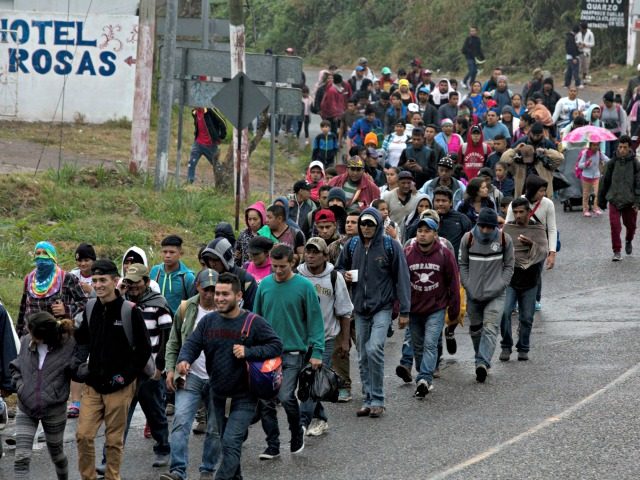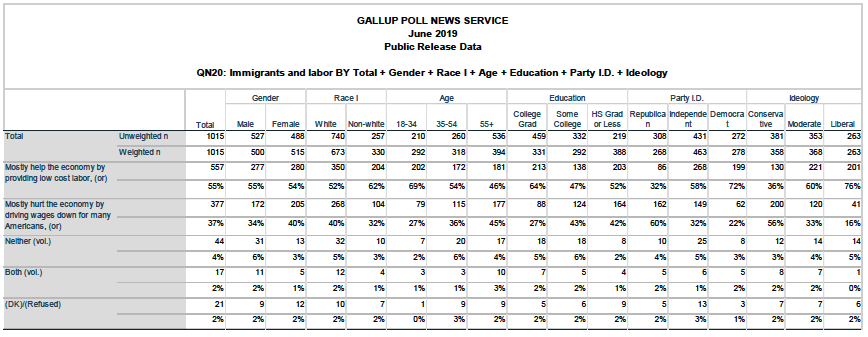Two-thirds of wealthier college graduates say immigration helps the economy by providing cheap labor, according to a Gallup poll.
Overall, 64 percent of university graduates say immigrants “mostly help the economy by providing low-cost labor,” says the June poll data.
Just 27 percent of Americans college grads said immigrants “mostly hurt the economy by driving wages down for many Americans.”
In contrast, about 42 percent of high school graduates and “some college” respondents said that immigration hurts the economy by adding cheap labor, creating a 15-point gap.
The 15-point gap result is striking because it highlights the very different perspective between white-collar and blue-collar voters over cheap labor migration.
But the divide is also ironic because younger college graduates increasingly suffer from cheap labor migration.
The inflow of foreign graduates and college graduate visa workers — such as H-1B, OPT, and L-1 visa workers — is holding down salaries for college graduates while also spiking their rents and mortgage payments. Those housing costs are highest in the mostly white neighborhoods where college graduates compete for housing far from the chaotic diversity that immigration imposes on blue-collar America.
The class divide appears in several Gallup questions.
For example, 53 percent of college graduate Americans say the economy is made better by immigrants, while just 21 percent of college graduates say the economy is made worse by immigration. Thirty-six percent of the “some college” and the “high school” groups say the economy is made worse by immigration, so creating a 15-point class difference.
The class split appears again when the respondents were asked about immigration levels.
Prior polls have shown that few Americans know how many migrants arrive each year, and fewer Americans recognize that the federal government annually brings in one new legal immigrant — plus one temporary worker — for every four Americans who turn 18.
But the Gallup poll shows that only 21 percent of the college group want immigration reduced, while a 45 percent plurality of the high school group wants migration reduced. Thirty-three percent of college grads want immigration boosted, while only 22 percent of high school graduates want it increased.
The Gallup poll, however, is weakened by the absence of intensity answers. Gallup did not release data showing the percentage of each group that has strong opinions on the questions, so it is impossible to tell how many in each group care enough about an issue for it to shape their voting behavior.
Yet the class split is seen in many aspects of the nation’s political dispute over wages, labor supply, diversity, and migration.
On January 25, for example, the president of the prestigious Massachusetts Institute of Technology declared that migration is the “oxygen” that keeps America alive. The “Nation of Immigrants” pitch was made by L. Rafael Reif, a Venezuelan-born immigrant eager for more immigration:
In a nation like ours, immigration is a kind of oxygen, each fresh wave reenergizing the body as a whole. As a society, when we offer immigrants the gift of opportunity, we receive in return vital fuel for our shared future. I trust that this wisdom will always guide us in the life and work of MIT. And I hope it can continue to guide our nation.
Mass immigration allows progressive Americans to do what they want — to declare their independence from their fellow Americans, disavow the national solidarity that preserves mutual loyalty and trust among the various parts of the fractious United States.
The Gallup poll shows a very different picture from the “Nation of Immigrants” push polls often funded by businesses and progressive outlets. These “Nation of Immigrants” polls exaggerate public support for cheap labor migration because they pressure ordinary Americans to say they welcome many migrants, despite the United States as a country of mostly British settlers.
The alternative “priority or fairness” polls — plus the 2016 election — show that voters in the polling booth prefer to put a much higher priority on helping their families, neighbors, and fellow nationals get decent jobs in a high-tech, high-immigration, low-wage economy.
Gallup’s poll provides good evidence that swing voters are weak supporters of migration because very few voters think immigration delivers job market benefits to them or their families, regardless of education level.
For example, only 19 percent of college graduates say immigration creates job opportunities for themselves and their families, while 28 percent say immigration worsens their families’ job outlook.
Among “some college,” the split is similar, with merely 12 percent saying “better,” and 32 percent saying “worse.”
Among the high school group — which includes many immigrants — the split is 24 percent for “better” and 30 percent for “worse.”
Roughly 56 percent of each group — including 68 percent of college graduates — say immigration is “not having much effect” on career opportunities.
Immigration by the Numbers:
Each year, roughly four million young Americans join the workforce after graduating from high school or university.
But the federal government then imports about 1.1 million legal immigrants and refreshes a resident population of roughly 1.5 million white-collar visa workers — including approximately one million H-1B workers — and approximately 500,000 blue-collar visa workers.
The government also prints more than one million work permits for foreigners, tolerates about eight million illegal workers, and does not punish companies for employing the hundreds of thousands of illegal migrants who sneak across the border or overstay their legal visas each year, despite the rising loss of jobs to automation.
This policy of inflating the labor supply boosts economic growth for investors because it ensures that employers do not have to compete for American workers by offering higher wages and better working conditions.
Flooding the market with cheap, foreign, white-collar graduates and blue-collar labor also shifts enormous wealth from young employees towards older investors, even as it also widens wealth gaps, reduces high-tech investment, increases state and local tax burdens, and hurts children’s schools and college educations. It also pushes Americans away from high-tech careers and sidelines millions of marginalized Americans, including many who are now struggling with fentanyl addictions. The labor policy also moves business investment and wealth from the Heartland to the coastal cities, explodes rents and housing costs, shrivels real estate values in the Midwest, and rewards investors for creating low-tech, labor-intensive workplaces.


COMMENTS
Please let us know if you're having issues with commenting.